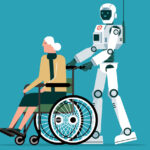Clinicians, particularly non-GP specialists, need to be convinced to come along for the interoperability ride.
Making a blood donation is such a simple way to help save a life. June’s World Blood Donor Day activities reminded us all how easy it is to be a lifesaving blood donor: find a donor centre, make an appointment, set aside about 30 minutes and finish with a free snack.
The far more complex bit happens behind the scenes. Screening the blood, tracking and managing it, monitoring usage and demand, and distributing vital blood products to every hospital. This is one of those instances where the right product at the right time is critical, with very little room for error.
It’s a process that, without digital connectivity and a unified system would be a logistical nightmare. Yet while the technology exists for linking vital records and data, pieces of our healthcare system remain disconcertingly disconnected.
One of my friends was recently in the ACT for work, became unwell and had to visit an emergency department. Tests done. Acute symptoms managed. Friend discharged. The system worked as it should, until my friend returned home to Queensland.
A trip to the GP soon followed and with it the realisation that all the information relating to the tests, treatment and management received at a public hospital in the ACT did not make its way to the GP. On top of the stress of dealing with a medical issue, my friend also had to get in touch with the ACT hospital to get copies of their medical records to pass on to their GP.
In my friend’s case, the lack of shared records was an unnecessary stressor, but the consequences can be much more dire. Without access to a patient’s full medical history, such as existing conditions, medications and allergies, it is very difficult for doctors, nurses and other medical professionals to make truly informed decisions about treatment. A pre-existing condition could be overlooked, or an incorrect medicine could be prescribed with potentially fatal consequences.
All our health records need to be linked up, attached to our Individual Healthcare Identifier (IHI) if we have one, and be secure but accessible to us and to the medical professionals that we entrust with our healthcare.
The solution exists but uptake is lagging. My Health Record statistics from the Australian Digital Health Agency show that while more than 90% of Australians (23.5 million people) have a My Health Record and GP registration on the national digital records system is 99%, only 36% of medical specialists are registered and just 17% of specialists are actually accessing the digital records available in My Health Record.
Budget focus on connectivity and interoperability
The spending signalled in the 2023-24 budget shows the Australian government recognises the need to prioritise unified, accessible health records.
Digital health is getting new funding of $951.2 million over four years including $325.7 million for the Australian Digital Health Agency to support delivery of important digital health infrastructure, $429 million to modernise My Health Record, and $126.8 million to renew the Intergovernmental Agreement on National Digital Health, which is focused on the promotion of interoperability across the health system. An additional $111.8 million will be invested over four years to strengthen electronic prescribing and enhance targeted digital medicines.
The budget bodes well. Right now, we could be standing at the precipice of reshaping our healthcare experience and reducing the fragmentation, but we need to remember that funding is just one piece of the puzzle.
For those specialists that are yet to sign on, some of their reluctance may come from a preference for the status quo, but in many cases it will be an issue of time, staffing and relevancy (specialists are generally treating specific conditions at a point in time rather than looking at the patient’s health holistically like a GP). Their time is best spent treating patients and it will require some resources and support to make the shift to storing their notes and results in the My Health Record system.
In other cases, the existing software in their consultancy may not have the right application programming interfaces to “talk” to the other system or there might be concerns about the security of these records (massive focus has been given to privacy and security of the My Health Record system but ongoing vigilance is necessary).
Whatever obstacles have prevented them from signing on before now, every healthcare professional must be brought along on the journey if we are to achieve a truly unified health system.
To drive that change, we need to talk about digital health in terms of the real outcomes for people, not just budgets and statistics. A unified system and greater interoperability will give our medical professionals a greater ability to understand and support each patient’s health journey, and it will improve diagnosis and continuity of care which will result in better health outcomes for everyone. Improved reporting and more end-to-end data will also provide better insights into our healthcare system and help us create a plan to manage the growing challenges faced by the sector.
Pauline Soo is health director at Datacom.





